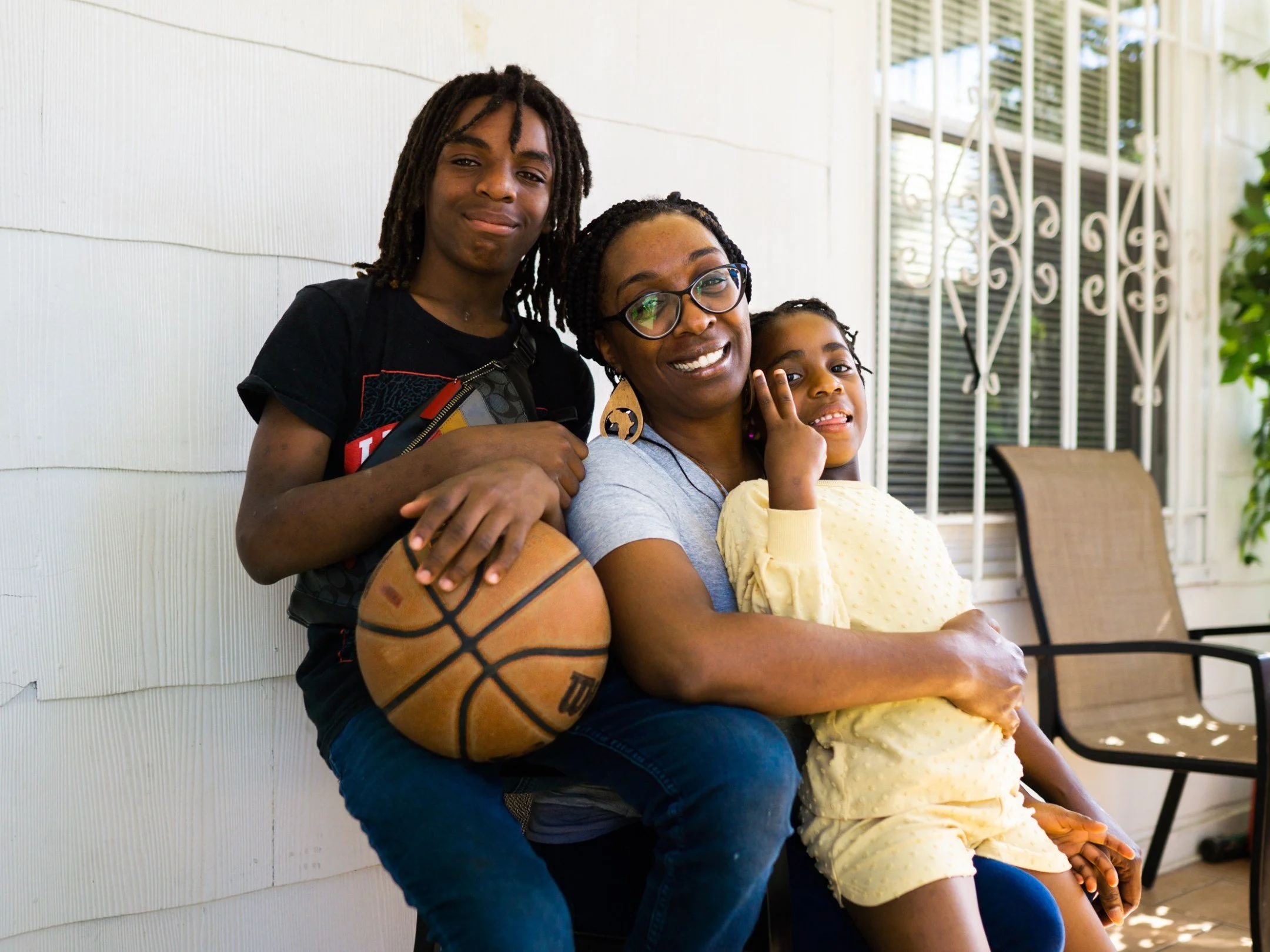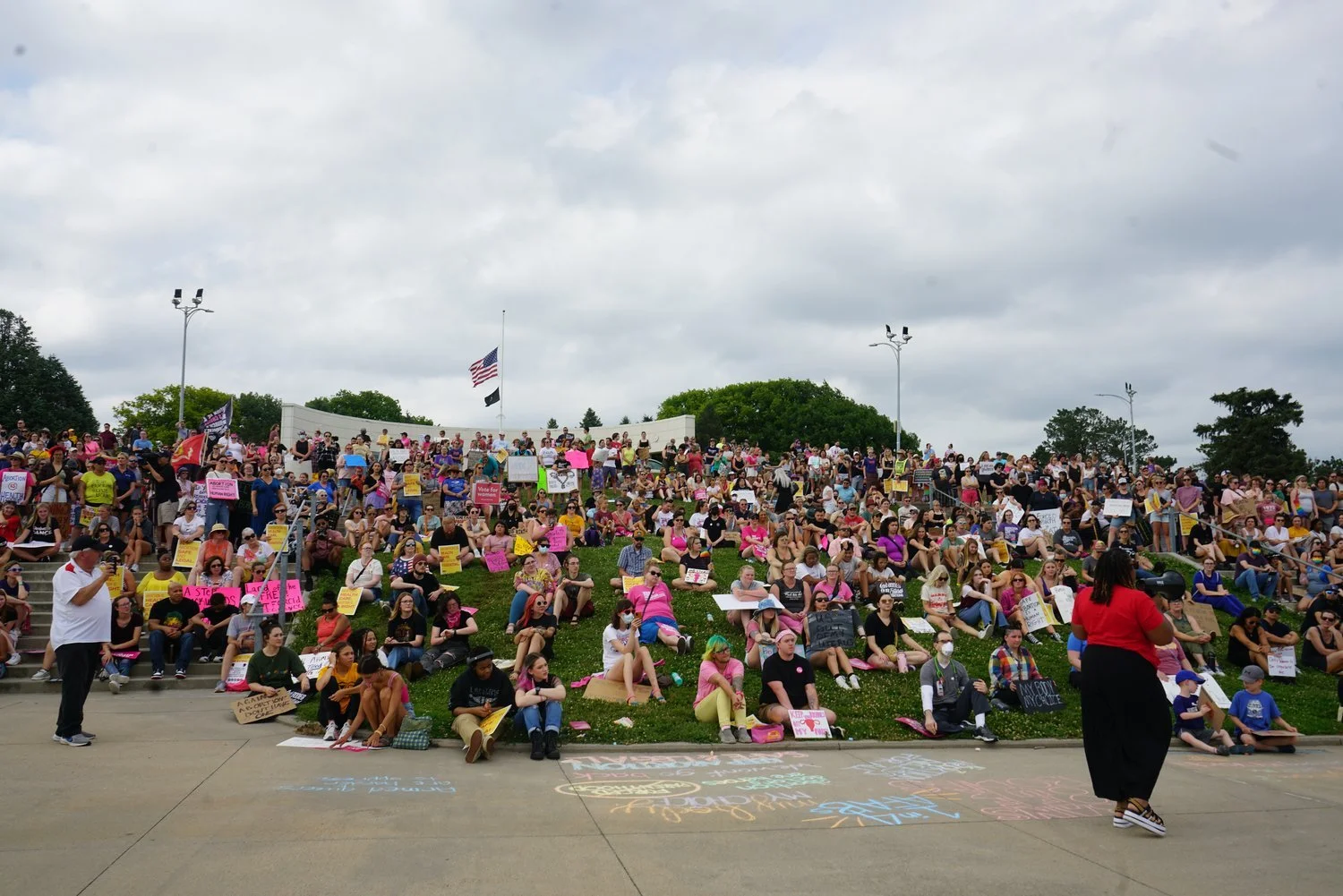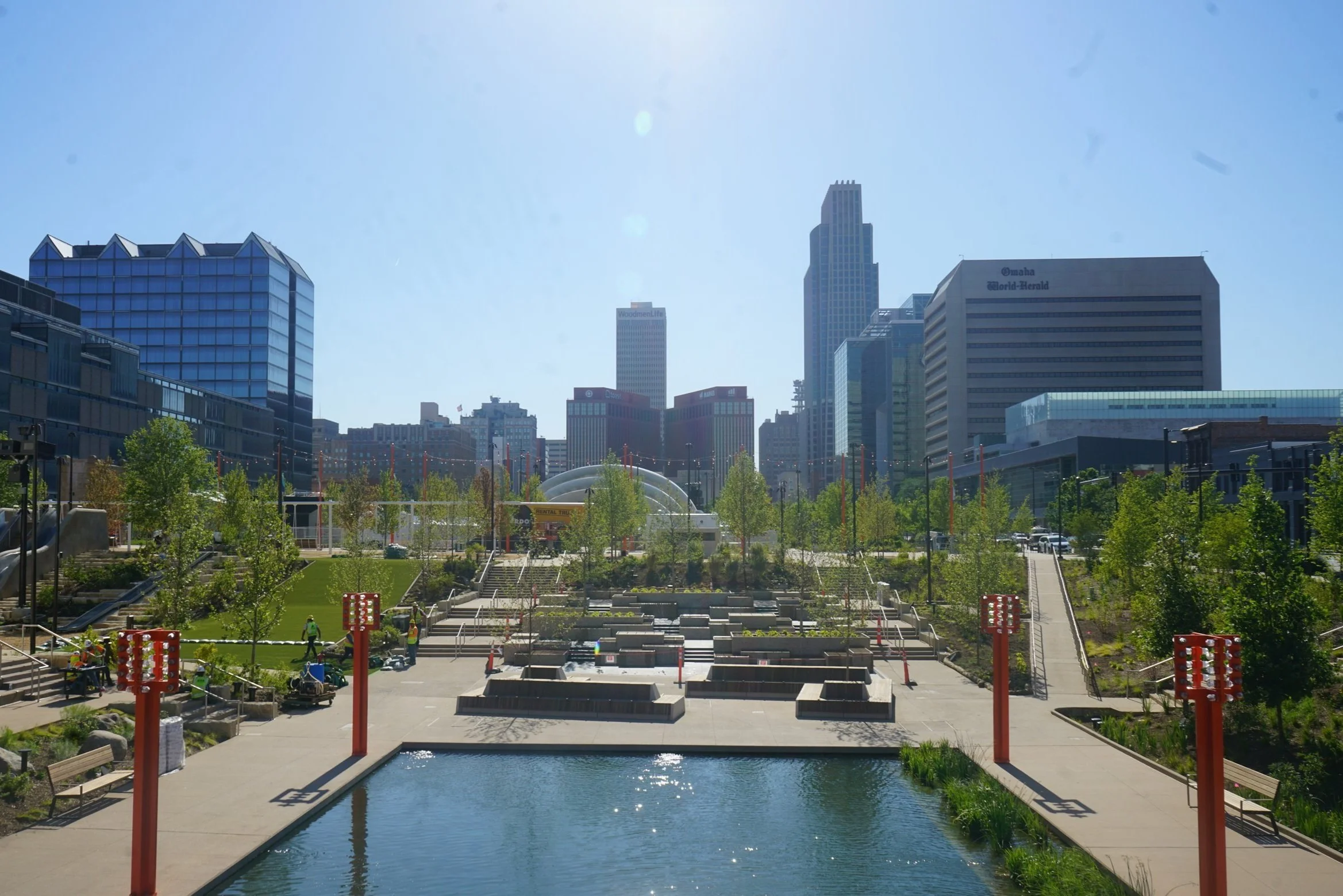2022 Face-to-Face With Black History Civil Rights Tour: “The Best One Yet.”
Tour participants at Tuskegee University in Alabama surround a statue of Booker T. Washington with a man liberated from enslavement. The caption reads, “He lifted the veil of ignorance from his people and pointed the way to progress through education and industry.” Photo credit: M.David Clark
By Elle Love
The Face-to-Face With Black History Tour, founded by Preston Love Jr. in 2018, has logged another successful trip. Students from predominantly North Omaha schools learn about Black history by visiting historic civil rights landmarks in the South.
“If you would draw a circle and make a pie chart, there are numerous pieces in the pie of the learning process that we teach them,” Love said. “The learning of the historical facts and history of voter suppression is a big slice, but not the only slice.”
Outside the Lorraine Motel in Memphis, Tenn. Photo credit: M. David Clark
The first stop on the tour was Memphis, Tennessee to view the National Civil Rights Museum at the Lorraine Motel where Rev. Dr. Martin Luther King, Jr. was assassinated on April 4, 1968. Looking inside the room where he stayed was one of two truly somber moments for the students, according to Love.
The group visited two Memphis churches that were active in the civil rights struggle, the Mason Temple, where Dr. King made his final speech, and the Clayborn Temple where activists created the “I AM A MAN” signs used by striking workers.
The group moved on to Jackson, Mississippi where, for the first time, the participants were able to walk around the exterior of the home of slain NAACP field secretary Medgar Evers. They touched the spot on the driveway where he was gunned down.
Left: Home of Medgar Evers in Jackson, Miss. Right: 16th St. Baptist Church in Birmingham, Ala. Photo credit: M. David Clark
In Birmingham, Alabama they toured the 16th St. Baptist Church where four girls were killed in a 1963 bombing by the Ku Klux Klan. At the Birmingham National Civil Rights Museum they saw a replica of a Freedom Riders’ bus and the actual jail cell door where Dr. King wrote his famous “Letter From Birmingham Jail.”
Crossing the Edmund Pettus Bridge in Selma, Ala. Photo credit: M. David Clark
In Selma, the group walked across the Edmund Pettus Bridge where dozens of people, including civil rights activist John Lewis, were beaten by police on “Bloody Sunday” in March of 1965 while marching to the state capital to advocate for voting rights. They also toured the city’s Voting Rights Museum.
In Montgomery, they explored the Rosa Parks Museum which commemorates her role in the 13 month-long bus boycott in 1955 - 1956 as well as the Dexter Ave. Baptist Church which served as Dr. King’s office while he directed the boycott.
At the memorial to victims of lynching in Montgomery, Ala. Photo credit: M. David Clark
Other Alabama stops included the National Memorial for Peace and Justice, founded by the Equal Justice Initiative in 2018, which is dedicated to remembering the history of slavery and the terror of lynching during the Jim Crow era. Seeing the lynching memorial was the second time Love noticed an especially serious and somber demeanor among the youth. Nearby, they visited a famed educational institution, Tuskegee University, founded by Booker T. Washington in 1881 where they posed for the official group tour photo.
A new feature of this year’s trip was a stop in Atlanta to see the movie studio of filmmaker and playwright Tyler Perry, who is credited with founding the first Black-owned film production studio in the United States.
The group even found time to visit several HBCUs (Historically Black Colleges and Universities) in the Atlanta area including Morehouse and Spellman.
Reflections From the Tour Leader and a Chaperone
Five groups of students with a chaperone were assigned a team name honoring a civil rights leader— A.G. Gaston, Viola Liuzzo, Medgar Evers, Adam Clayton Powell, and Fannie Lou Hamer.
“We break them off into teams and there’s several sub-leadership things in there. One is that they bond better in teams. They are not isolated and there is a little peer pressure in the team because each team has a name of a famous [civil rights leader] that they don’t know anything about and they have to study about that. And then when they present at the banquet at the end of the tour, everyone on their team has to talk,” Love said.
The tour also assigned the participants a journal to reflect on what they learned in each of the destinations visited. Volunteer chaperone Manne Cook said the participants would have a group discussion in the evening with Love and their peers to talk about the landmarks and their significance.
Photo credit: M. David Clark
“You have the reflections from the book and the prompt to the questions, but then at that time, they will talk with each other about ‘What did you think about A.G. Gaston or the Edmund Pettus Bridge?” Cook asked.
Gaston is a little known successful Black businessman from Alabama who owned businesses ranging from funeral homes to an insurance company. He was an ardent supporter of the civil rights movement.
“‘Today, we’re in Memphis. Which of the stops did you enjoy the most or what did you think of the Lorraine Motel?’ We actually have those kinds of pre-questions. And every evening, we have a reflection session where we talk about that,” Love said.
The most memorable part of the tour for Cook was the group discussion over renaming the Edmund Pettus Bridge. Pettus was a Confederate veteran, a slavery supporter and a leader of the Ku Klux Klan.
Alabama lawmakers on April 6 of this year voted to change the name to the John Lewis Bridge after the late civil rights activist and former Representative for Georgia’s 5th Congressional District.
“That stood out to me because you had some people who said, ‘Yeah, change it,’ and you had some people who said ‘Keep it the same.’ But it’s deeper than that,” Cook said.
Love and Cook both agreed that the most important benefit of the tour is that students begin to consider what they are learning within the context of today’s social issues.
“When they start having the discussions, they now know what the Edmund Pettus bridge is as opposed to the Powerpoint. This is real. They walked across that bridge,” Love said.
“Kids don’t have to wash cars or fundraise to take part of our tour.”
He said chaperones are welcome to join in on the group discussions— up to a point.
“We don’t want the adults to be adults while they [students] are trying to learn and express themselves the way they like to. That’s why we don’t allow the parents there,” Love said.
Cook believes the learning experience includes personal growth along with historical facts.
“They learn some skills that are professional but also interpersonal skills like public speaking, '' he said.
Love remembered one of the participants named Malakai was too nervous to introduce himself before he participated in discussions. By the end of the tour at the banquet, he started presenting with his team.
“Those kids on day one would have to stand up and give their names and half of them couldn't pull it off,” Love said. “We’re watching them and teaching them how to have the confidence to stand up and talk.”
“I had one of the kids that I related to and he related to me. He had gang stuff in his former and present life. He was a different kind of guy who came onto the tour with a different kind of life. He wasn’t a scholar trying to learn more and he turned out to be an exemplary person. I wanted to relate to him. So he was going to play football and I told him I played football so that built something. So throughout the tour, it became a link. There were some things that were going on that made me glad we had that relationship.”
Over 300 alumni have taken the Face-to-Face With Black History Tour. Two of the alumni have gone on to attend Howard Law School.
Love speaks to participants before departure in Omaha; Museum exhibits in Memphis and Birmingham. Photo credit: M. David Clark
Alumna Marianna Miller recently spoke out against students wearing hate symbols in her high school in Bismarck, North Dakota.
“When she got up there, kids were wearing t-shirts with the Confederate flag on it. She had enough confidence and went to the school board, stood up, and made a presentation on why that wasn’t right. They were conservative but the vote was 7 - 0 in her favor and they banned the shirts based on what she said,” Love said. “Her video said she would have never had the confidence, had she not gone on the tour. I love that story. That’s just the testimony of one of many, many that makes [those of] us that work on the tour just prideful.”
Behind the Scenes
In the beginning, Love recruited Black youth in Omaha through organizations including Girls Inc., Boys and Girls Club, Hope Center, Avenue Scholars, Urban League and more.
After the tour became established, the demand and interest increased and it expanded to several high schools.
“We started having people knocking on our door,” Love said as he knocked on the table. “And those who knocked on our doors are individuals who wanted their son or daughter to go.”
Love and his staff must raise over $70,000 each year. While planning for the tour, they arrange for transportation, hotel stays, food, museum fees and other accommodations. His next big move is to start a national association of Black tour providers to network with others. He said the collaboration can increase buying power with hotels. He works with Arrow Stage Lines to provide group transportation.
In the evening, participants write in their reflective journals. Photo credit: M. David Clark
Information students share from their reflective journals serves as indirect feedback on how the tour can improve on the program.
“We make changes. We make mistakes, but that’s the formula. We adjusted it, made it better, and this was the best one yet,” Love said.
One of the great advantages of the tour is that students don’t have to pay to go.
“I insisted on having it that way so that kids don’t have to wash cars or fundraise to take part of our tour,” Love said. Due to the many requests from community members who want to go on the tour, Love offers around 20 spots for paying adults. He said he has reams of testimonials from people who have gone on the tour.
Love conducted an informal survey of how many students from different high schools had participated in the tour.
“It was not only OPS, but it was really where the Black kids went. We now have kids coming from private schools, all kinds of districts so it’s very diverse,” Love said. “I’ve enjoyed every minute of that. I really designed this originally for Black kids. Now it’s taking on its own life.”
Every year, Love hopes there will be equal numbers of boys and girls participating, but invariably, the girls outnumber the boys.
At the National Memorial for Peace and Justice in Montgomery, Ala. Photo credit: M. David Clark
Love believes students from all over the country should take part in this kind of educational travel.
“You would think that the kids in the South don’t need it. We always see several charter buses full of kids from other tours but they are not all from Kansas. They’re from Mississippi, Alabama, and all of that. That’s a dynamic,” Love said.
For more information about participating in next year’s tour or to volunteer as a chaperone email Preston Love Jr. at prestonlovejr@gmail.com or call 402-812-3324.

























